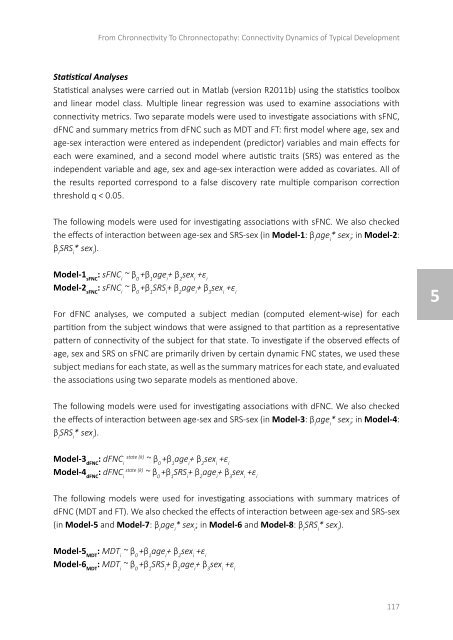On the Spectrum
2lm5UyR
2lm5UyR
You also want an ePaper? Increase the reach of your titles
YUMPU automatically turns print PDFs into web optimized ePapers that Google loves.
From Chronnectivity To Chronnectopathy: Connectivity Dynamics of Typical Development<br />
Statistical Analyses<br />
Statistical analyses were carried out in Matlab (version R2011b) using <strong>the</strong> statistics toolbox<br />
and linear model class. Multiple linear regression was used to examine associations with<br />
connectivity metrics. Two separate models were used to investigate associations with sFNC,<br />
dFNC and summary metrics from dFNC such as MDT and FT: first model where age, sex and<br />
age-sex interaction were entered as independent (predictor) variables and main effects for<br />
each were examined, and a second model where autistic traits (SRS) was entered as <strong>the</strong><br />
independent variable and age, sex and age-sex interaction were added as covariates. All of<br />
<strong>the</strong> results reported correspond to a false discovery rate multiple comparison correction<br />
threshold q < 0.05.<br />
The following models were used for investigating associations with sFNC. We also checked<br />
<strong>the</strong> effects of interaction between age-sex and SRS-sex (in Model-1: β I<br />
age i<br />
* sex i<br />
; in Model-2:<br />
β I<br />
SRS i<br />
* sex i<br />
).<br />
Model-1 sFNC<br />
: sFNC i<br />
~ β 0<br />
+β 1<br />
age i<br />
+ β 2<br />
sex i<br />
+ε i<br />
Model-2 sFNC<br />
: sFNC i<br />
~ β 0<br />
+β 1<br />
SRS i<br />
+ β 2<br />
age i<br />
+ β 3<br />
sex i<br />
+ε i<br />
For dFNC analyses, we computed a subject median (computed element-wise) for each<br />
partition from <strong>the</strong> subject windows that were assigned to that partition as a representative<br />
pattern of connectivity of <strong>the</strong> subject for that state. To investigate if <strong>the</strong> observed effects of<br />
age, sex and SRS on sFNC are primarily driven by certain dynamic FNC states, we used <strong>the</strong>se<br />
subject medians for each state, as well as <strong>the</strong> summary matrices for each state, and evaluated<br />
<strong>the</strong> associations using two separate models as mentioned above.<br />
5<br />
The following models were used for investigating associations with dFNC. We also checked<br />
<strong>the</strong> effects of interaction between age-sex and SRS-sex (in Model-3: β I<br />
age i<br />
* sex i<br />
; in Model-4:<br />
β I<br />
SRS i<br />
* sex i<br />
).<br />
Model-3 dFNC<br />
: dFNC i state (k) ~ β 0<br />
+β 1<br />
age i<br />
+ β 2<br />
sex i<br />
+ε i<br />
Model-4 dFNC<br />
: dFNC i<br />
state (k)<br />
~ β 0<br />
+β 1<br />
SRS i<br />
+ β 2<br />
age i<br />
+ β 3<br />
sex i<br />
+ε i<br />
The following models were used for investigating associations with summary matrices of<br />
dFNC (MDT and FT). We also checked <strong>the</strong> effects of interaction between age-sex and SRS-sex<br />
(in Model-5 and Model-7: β I<br />
age i<br />
* sex i<br />
; in Model-6 and Model-8: β I<br />
SRS i<br />
* sex i<br />
).<br />
Model-5 MDT<br />
: MDT i<br />
~ β 0<br />
+β 1<br />
age i<br />
+ β 2<br />
sex i<br />
+ε i<br />
Model-6 MDT<br />
: MDT i<br />
~ β 0<br />
+β 1<br />
SRS i<br />
+ β 2<br />
age i<br />
+ β 3<br />
sex i<br />
+ε i<br />
117


